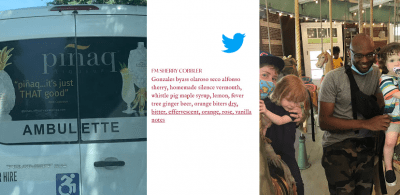Covid case study: How this eatery pivoted—and pivoted again
Cremini’s Aperitivo & Kitchen had just opened when the pandemic hit, but through ingenuity and improvisation, they’re surviving


The Massettis
Italian newlyweds Riccardo and Elena Massetti, inspired during a holiday in America, decided to open an Italian restaurant in Brooklyn. Cremini’s Aperitivo & Kitchen would be a labor of love, with Riccardo on the aperitivos and Elena in the kitchen. The quaint eatery at 521 Court Street, owned and operated by the couple, would be the only one in New York to feature the cuisine of Italy’s eastern Le Marche region. It’s a love story, a serenade to an enchanting city.
And it’s a case study in epically, catastrophically, cosmically bad timing.
Cremini’s officially opened in January of 2020. Everyone knows what came next. The immense complications of restaurant life in the time of coronavirus were exacerbated not only because Cremini’s was a brand-new establishment in a brand-new environment, but also because the Massettis were newbie restaurateurs themselves. Riccardo had a marketing background; Elena worked as an architect. Neither had actual restaurant experience.
Yet, Cremini’s Aperitivo & Kitchen has survived the longest year in memory. And their success to date can be attributed to a series of steps akin to the Hustle, a dance that originated in our borough and, in many ways, reflects its ingenuity.
There may not be a playbook for how to survive a pandemic, yet. But if the Massettis are an example, it might look a bit like this:
Take it out
As soon as the lockdown approached and indoor dining ended, the couple adapted their menu to accommodate dinners for take-out and delivery, including full meals paired with cocktails and/or bottles of wine. They also opened for lunch and introduced paninis and other lunch-friendly items in order to feed their many Brooklyn neighbors now working from home. “This was like a shock for us,” Riccardo says. “We were prepared to serve dinners only, inside our restaurant, and now we are changing the menu for lunch, having to learn about GrubHub and DoorDash, arranging pick-up orders online.”
Step to the front
With the first phase of reopening in June, the sidewalk outside of Cremini’s was outfitted with antique tables separated by greenery and backed by a trellis-draped storefront. Somehow, they established an oasis of fresh air and ambiance, occupied every night, half-a-block from the BQE. “For me, this was a pleasure,” says Elena. “I took so much pride in doing the interior of the restaurant, and I was so happy to make a comfortable place for our customers outside to not just pick up and go home but to enjoy an aperitivo from Riccardo and some of our food and wine with us in person.”
Step to the back
The restaurant’s spacious concrete back garden had to be completely refurbished to allow for al fresco dining, but the couple worked for weeks before and after opening, cleaning and then decorating a pebble-floored dining patio with canopied tables and a muraled-wall. “This was a lot of work,” Riccardo says. “It was not so beautiful back there before.”
Step inside
Phase Two of reopening allowed 25 percent capacity. Tables inside Cremini’s were spaced accordingly. The bar that extends from kitchen to the dining area allowed for an efficient tag team of back-of-the-house and front-of-the-house to service the room efficiently while keeping those outside happy as well. “It almost felt normal, except for that we were wearing masks,” says Elena.
Fake it till you make it
When indoor dining ended again with the arrival of winter, the only move left in the Cremini’s repertoire was takeout, so they developed their own product line: olive oil, balsamic vinegar, jarred artichokes and bruschetta toppings as well as Italian wines and delicacies mostly from Le Marche, but not exclusive to the region that inspired the eatery. Additionally, the signature dishes of the menu, Cremini (breaded and fried custard cubes in six variations) and Ascolana Olives (pitted green olives, in six variations, stuffed with minced meat and aromatics, breaded and fried) are now prepared to be fried at home. In the meantime, the couple is in the process of winterizing the back garden to help survive the long months ahead.
“Now is the biggest challenge,” Riccardo says. “We don’t make any money because it is very quiet now, but we must invest money at the same time. The last year was terrible, and maybe the next six months will be terrible, but we must also maintain the same high quality that we have because we don’t want to lose our reputation with our many friends in Brooklyn.”
You might also like 


























